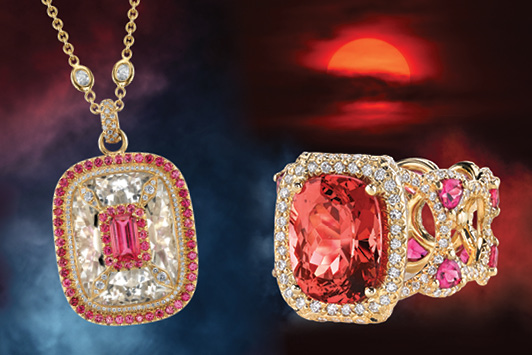
Ask anyone in the colored-gem sector what their favorite stone is, and the answer will frequently be spinel. Representing the perfect marriage between the brilliance of a diamond and the vibrant nature of a colored stone, spinels are witnessing a resurgence as designers and consumers gravitate toward their distinctive personality.
Not a ruby
While spinels may seem like a recent phenomenon, their story is as old as that of the gems they were mistaken for in the West: rubies. Before the Mughals, rubies, pearls and diamonds were the gemstones that the natives of Hindustan (today India) traditionally valued. When Mughal emperor Humayun returned to Hindustan in the mid-16th century after 15 years of exile in Persia, he brought the influence of Persian art and culture, which valued spinels above all gems.
“In Persian culture, red stones were admired because they evoked...the light of dusk that filled the sky when the sun had just sunk below the horizon,” explained author and historian Assadullah Souren Melikian-Chirvani in a 2001 paper. Spinels were first called “balas-ruby” or “balkh” — derived from the Sanskrit word “
balasuryaka,” meaning the crimson-colored morning sun, according to a 1996 book by professors A. and S. Biswas.
While the East understood and appreciated the beauty of spinels, for a long time, the West incorrectly labeled them as rubies (for example, the 170-carat Black Prince’s Ruby in the Imperial British Crown). As the science of mineralogy developed in the West, the “balas ruby” was correctly identified as a separate mineral and renamed “spinel,” from the Latin “spina,” or thorn, due to its natural octahedral shape.
With the passage of time and fading memories of their esteemed position, spinels became known as the “dealer’s stone” because gem merchants tried in vain to promote it to customers who were unfamiliar with the new name and its history. Market sentiment, however, changed in 2007, when an artisanal miner digging in a farmer’s field outside the Tanzanian town of Mahenge found a pink-red spinel crystal.
“I’ll never forget seeing images of the originally 52-kilogram trigon spinel from Tanzania,” recalls Dave Bindra, vice president of B&B Fine Gems. “No region in the world has produced spinel quite like this, and I believe this locality was instrumental in igniting the flame that set the spinel market on fire.”
Admirable traits
Romantic notions of the ancient world aside, the science of spinels offers several reasons for their appeal. First, thanks to their cubic crystal system being singly refractive of light, their appearance remains constant, and they sparkle like diamonds, making them a beautiful gem to wear at night. Second, like rubies, red spinels glow, capturing the UV rays of the sun and returning them to our eyes in a fireball spectacle. Third, besides sharing a color with rubies, red spinels have a similar hardness, as do spinels of other hues: 8 on the Moh’s scale, compared with 9 for ruby, opening up great possibilities for designers. Finally, while 80% to 90% of colored gems undergo enhancement of some kind, most spinels don’t require any treatment — a bonus, considering the growing consumer demand for untreated gems.
As a result of these and other qualities, top-grade red spinels can cost as much as unheated rubies.
Designer Erica Courtney is a prolific employer of spinels in her jewelry. Cut-wise, she says, “I use ovals the most, but I am very interested in marquise right now, although they are difficult to source. Most customers don’t know about spinels, and I enjoy educating them about the gem’s character, diverse colors and rich history.”
Mahenge spinels from Tanzania are a particular favorite of Courtney’s “because of the rarity and the inherent fire they display. I use the term ‘tequila sunrise’ to refer to the top color in Mahenge spinels, which is an orangey-fuchsia pink or intense pink with a splash of orange.”
Appreciating value
In terms of demand, red spinels rule the roost, probably due to their visual similarity to rubies. All else being equal, material from historic deposits like Burma (Myanmar) still commands a premium. Connoisseurs and designers also pay top dollar for cobalt-blue spinels, probably the rarest color. Other, more accessible colors carving a niche for themselves are pale-pink, lavender, purple, orange and grey.
“As public awareness regarding spinels has grown over the last 20 years, the prices for the brightest colors have increased exponentially — sometimes 100 times, even 1,000 times for top-grade variety,” says Josh Saltzman of Nomad’s. So-called “Jedi” spinels, a highly florescent pinkish-red variety from Burma — specifically the Namya area and the Man Sin region in Mogok — have seen the greatest increase in their estimates, Saltzman continues, as have cobalt-blue spinels from Vietnam. Reds and vibrant pinks are “not far behind. While other colors have also appreciated on the rising spinel tide, it hasn’t been as dramatic as the ones mentioned above.”
If these trends are any indication, the desire to possess spinels will only intensify as more gem-lovers fall under their spell.
Image: Erica CourtneyArticle from the Rapaport Magazine - February 2020. To subscribe click here.